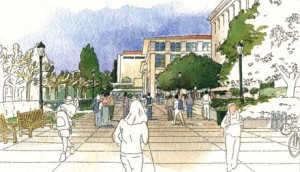Transforming City Life
Pedestrianizing Urban Space and Undoing the ‘Auto-cracy’
by Jay Walljasper
I am perplexed by the almost complete lack of pedestrian districts in North America. Why is it that car-free streets — designed for  pleasurable strolling, shopping, and hanging out — which have become as common as stoplights or McDonald’s in European city centers, are almost non-existent here?
pleasurable strolling, shopping, and hanging out — which have become as common as stoplights or McDonald’s in European city centers, are almost non-existent here?
I’ve only seen a few — a couple of blocks in downtown Boston, Rue Prince Arthur in Montreal, Third Street Promenade in Santa Monica, and short stretches of downtown streets in college towns like Boulder, Ithaca, Iowa City, Charlottesville, and Burlington, Vermont. (A glance at Wikipedia turns up a few more, although I notice many on the list, like the Nicollet Mall here in Minneapolis, are not truly car-free.)
Look what we’re missing.  The heart of many, if not most, German, Italian, Dutch, Scandinavian and, increasingly, South American big cities are bustling pedestrian zones that have become favorite spots for young people to gather, lovers to linger, kids to romp, women to show off their new clothes (and discreetly admire the looks of passersby), men to admire the looks of passersby (and discreetly show off their new clothes) and everybody to feel part of the wider community.
Our one widespread experiment in reclaiming the streets — the downtown transit malls of the ’60s and ’70s — failed in most cases. That’s because they were usually desperate measures to cure sickly downtown shopping districts overwhelmed by competition from shopping malls proliferating across the suburban landscape.
Another factor in transit malls’ rapid rise and fall is that they were not actually pedestrian places — big buses rumbling up and down the avenue quashed the carefree, car-free ambiance that fosters exuberant street life.
Finally last week, I discovered a genuine Euro-style ped-street in the most unlikely spot: Calgary, Alberta — a sprawling city whose economy depends on the petroleum industry. Right in the center of its downtown, among all the glass-sided skyscrapers and traffic-choked five-lane avenues, you can happily wander five blocks down the middle of Stephen Avenue, passing sidewalk cafes and swank shops, playful public art, and bustling public spaces, unencumbered by cars or trucks. It felt too good to be true.
And it was. I returned to Stephen Avenue for a twilight stroll when blue still brightens the June sky till after ten, and discovered cars cruising its narrow lanes. At 6 p.m., like Cinderella’s pumpkin coach in reverse, it turns back into a traffic artery — which makes no sense because the volume of cars and trucks downtown is easing up at that hour.
Why surrender this delightful pedestrian oasis to traffic when there’s no pressing need? I can only guess it’s the principle of the thing. In North America, the rightful role of roads is to carry traffic, so even if you want to pedestrianize a few blocks during the day for shoppers and the noontime lunch crowd, you are obliged to welcome back the Toyotas and Lincolns in the evening.
Still, Stephen Avenue proves: If you keep out the cars, the pedestrians will come.
The notion that cars are the Kings of the Road is a relatively new attitude. For almost all of human history, the city street functioned as a vital public space — it’s where youngsters played, teens flirted, dogs slept and everyone else chatted with their friends. That all changed between the 1920s and the 1970s, depending where you live, as motorists claimed these commons for their exclusive use.  We are poorer today because of this — literally in some cases because to experience the instinctual joy of hanging out in the streets you must travel to some faraway spot.
Still, I am noticing a few signs this “auto-cracy†may be weakening, even in North America. The growth of traffic calming measures and bike lanes means that motorists are learning how to share the road.
And many of us are getting a foot back in the street thanks to modest pedestrian projects being created — a block here or a half-block there in spots like Rochester, Minnesota; Knoxville, Tennessee; and Charlottetown, Prince Edward Island.
Don’t underestimate what can arise from these small beginnings. Even a short stretch of car-free pavement empowers peds to realize the road belongs to them too. Jan Gehl, the influential Danish urban designer who applies lessons learned in creating Copenhagen’s famous pedestrian district to cities around the globe, counsels people to start small and add to it bit by bit through the years.
Another hopeful trend is the emergence of ciclovias — when a road is closed to traffic for a few hours so people can take over the streets for merriment. This bright idea was pioneered in Colombia, where networks of city streets are closed most Sunday mornings, with as many as a million people flooding the streets in Bogota on a sunny day.  The tradition is now migrating north, with El Paso, Texas; Las Cruces, New Mexico; Cambridge, Massachusetts; and Ottawa, Ontario among the cities holding regular events. Minneapolis holds its first today.
I am headed out to enjoy it right now.
Jay Walljasper is co-editor of OnTheCommons.org, and is the author of the new book All That We Share: A Field Guide to the Commons (The New Press, 2010). He is a Contributing Editor at National Geographic Traveler, a Senior Fellow of the Project for Public Spaces, and a Contributing Author for New Clear Vision.
